13 Gemmy Facts About Spinel
Color, luster, durability, and more. Spinel is an overlooked gem.
Author: Hobart M. King, PhD, GIA Graduate Gemologist
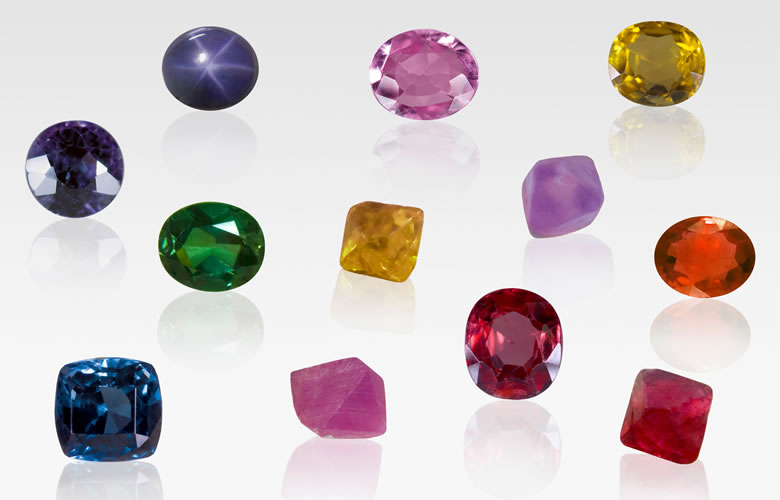
The Color of Spinel Speaks for Itself: A collection of spinels of various colors: Top row from left: a blue spinel cabochon displaying a six-ray star; a faceted purplish pink spinel; a faceted yellow spinel. Second row from left: a dark purplish blue faceted spinel; a bright green faceted spinel; a yellow octahedral crystal of spinel; a purple octahedral crystal of spinel with an abrasion-frosted surface; an orange faceted spinel (this particular color is known as "flame spinel"). Bottom row from left: a bright blue faceted spinel; a purplish pink twinned crystal of spinel; a bright red faceted spinel; a bright red octahedral crystal of spinel. Photos by Greg C. Grace / Alamy Stock Photo.
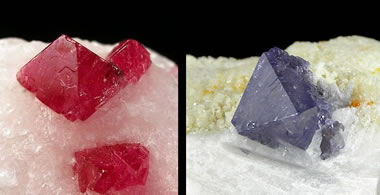
Crystals of Spinel: Much spinel is found as beautiful crystals in white marble. The crystals are often shaped like perfect octahedrons and frequently have colors that mimic ruby and sapphire. In the early days of gems, these red and blue spinels were often misidentified as ruby and sapphire. Specimens and photos by Arkenstone / www.iRocks.com.
The Most Overlooked Gem?
Spinel is a new birthstone with vivid colors that span the spectrum. It has a spectacular luster, excellent durability, and its current price might be at a low that you will never see again.
Here are 13 reasons why I believe that spinel is one of the world's most overlooked gems.
Table of Contents
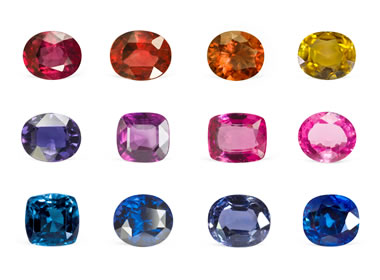
Colors of Spinel: Some of the many colors of spinel: top row: red, orangy red (flame spinel), orange, yellow; middle row: violet, purple, purplish pink, pink; bottom row: cobalt blue, blue, violetish blue, blue. Photo by Greg C. Grace / Alamy Stock Photo.
1. Spectacular Color
What color is spinel?
Spinel is every color!
Spinel is one of just a few gemstones that occurs in every color of the spectrum. Spinel can be red, orange, yellow, green, blue, violet or purple. White, brown, black, gray, and colorless spinels also exist. The image at the top of this page demonstrates the spectacular range of spinel's vivid colors.
Red and pink spinels receive their color from trace amounts of chromium. Many blue spinels receive their color from trace amounts of iron, but the most vibrant blues are colored by traces of cobalt. Purple and orange spinels are colored by traces of iron and chromium.

Pink Spinel: A faceted pink spinel with a brilliant luster. Photo by Greg C. Grace / Alamy Stock Photo.
2. Brilliant Luster
Luster is the intensity and quality of light that is reflected from the surface of a gem. The first (or the next) opportunity that you have to see a spinel, play it under a light. You will be impressed by its brilliant luster!
Spinel has the ability to accept one of the brightest polishes of all gems. The luster of a polished spinel is only exceeded by diamond, sphene and zircon - these gems have a polish luster known as adamantine.
Spinel has a subadamantine luster. The only other gems with that polish luster listed in the GIA Gem Reference Guide and the GIA Gem Identification Lab Manual are the corundums (ruby and sapphire); the chrysoberyls (chrysoberyl, alexandrite, and cat's-eye chrysoberyl); and, some varieties of garnet (andradite, malaia, and spessartine).
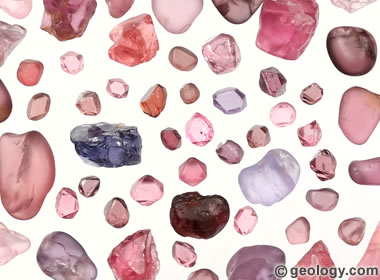
The Hardness of Spinel: Spinel is one of the hardest and most durable minerals. That durability enables crystals of spinel to survive being weathered from the rock in which they crystallized, transported long distances by the current of a stream, and be deposited as water-worn particles in a stream sediment. Most spinels are found by artisanal miners who prospect stream sediments hoping to find a gem. The colorful spinels in this photo were mined from stream sediments in Vietnam. The deep red piece of spinel in the lower center of the image measures 7 millimeters by 5 millimeters.
3. Superior Hardness
Spinel is one of the hardest gems. Hardness is the resistance of a material to being scratched. A high hardness helps a gem resist abrasion without scratching. This is a very important property for gems that will be worn for years - or for a lifetime.
Today an increasing number of couples are selecting colored stones for their engagement jewelry. This should put spinel and its superior hardness in the spotlight.
Spinel has a hardness of 8 (out of a possible 10) on the Mohs hardness scale. The only commonly used gem minerals that exceed its hardness are: diamond (10); corundum, the mineral of ruby and sapphire (9); and chrysoberyl, the mineral of alexandrite, chrysoberyl, and cat's-eye chrysoberyl (8 1/2). Topaz (8) and beryl, the mineral of emerald, aquamarine, morganite, and heliodor (7.5 to 8), are the only common gems that equal the hardness of spinel.
4. Toughness & Durability
Toughness is the ability of a material to resist breaking. Spinel is very tough. It does not exhibit cleavage (planes in its crystal structure that are prone to separation) like diamond and topaz. It is not as brittle or prone to fractures as emerald, topaz, and many other hard gems. Spinel is one of the tougher gem minerals.
Spinel is also very hard - only a few materials can scratch it. Spinel is tough - it does not break easily. Those two qualities make spinel one of the most durable gems. The most durable gems are both hard and tough. Spinel is durable enough for any jewelry use.

Spinel Ring: A vibrant pink spinel mounted in a white gold ring - a perfect gift for a person who likes red and who has an August birthday. Photo by directphoto.bz / Alamy Stock Photo.
5. The New August Birthstone
One of the most important things that can influence the popularity of a gem is to be named as a birthstone. That happened for spinel in July 2016, when the American Gem Trade Association and the Jewelers of America named it a birthstone for the month of August.
Spinel was unknown to most people when it was named a birthstone. Now more and more people are learning about it every year.
Spinel's sharing the August birthstone designation gives consumers a spectrum of color choices beyond the yellow-green of peridot.
The custom of giving birthstone jewelry as a gift, especially on birthdays, is strong in the United States and many other countries. This will drive sales of spinel jewelry and make spinel a gem of conversation among jewelry consumers. Just watch its popularity rise!

Engraved Spinel: The red baroque spinel in the photo above is inscribed with the Persian name of Mughal Emperor Jahangir and his grandson Alamgir. Jahangir ruled parts of Persia in the early 1600s. Photo by Denis Balibouse / REUTERS / Alamy Stock Photo.
6. Owned by Emperors and Kings
During the Middle Ages, many rulers of countries in Asia and Europe had their names inscribed on significant gems in their royal collections. Many of these stones survive uncut today, preserving the histories inscribed on their surface.

The World's Most Famous Spinel: "The Black Prince's Ruby" is actually a red spinel. It was mounted as the primary focal stone of the Imperial State Crown - part of the Crown Jewels of the United Kingdom. This illustration was created by Cyril Davenport in 1919.
7. The Focal Stone of Queens
The two most popular focal stone colors in jewelry are red and blue. Spinel occurs in red and blue hues that rival those of the finest rubies and sapphires.
In fact, it was not until the mid-1800s that European scientists and gem dealers learned that spinel and ruby were two different minerals. Before then, several spectacular spinels were used in the crown jewels of monarchs.
The most stunning example of a spinel being mistaken for ruby is a gem known as "The Black Prince's Ruby". It is actually a spinel mounted as the primary focal stone of the Imperial State Crown - part of the Crown Jewels of the United Kingdom.
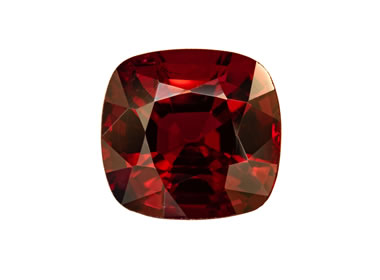
Spinel and Ruby: A faceted red spinel from the Mogok Region of Myanmar. If you had a ruby of identical color, clarity, cut, and carat weight, it would cost a lot more than this spinel - for a nearly identical appearance. As spinels become more popular, their prices are likely to rise. Photo by David Hayes / Alamy Stock Photo.
8. Rare But Relatively Inexpensive
Spinel is many times rarer than ruby, has comparable color, luster, and a wonderful appearance - but it sells for a fraction of the price. Why is that? An important reason is that jewelry manufacturers and jewelry buyers are still not thinking about spinel - and that makes spinel a gem that does not have a high demand - yet!
You should expect more and more people to walk into jewelry stores and ask to see spinel jewelry. Why? They were born in August and just learned that spinel was the new August birthstone.
Or, the shopper might be looking for a unique birthday gift for a person born in August and whose favorite color is red. They might be thrilled to get a red birthstone, learn about spinel, and show their spinel to every one of their friends. Word-of-mouth is the direct path to a gem's popularity.
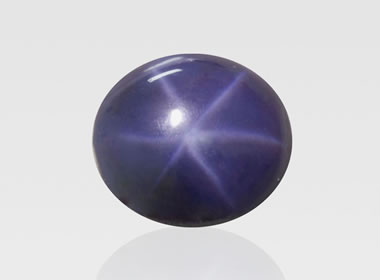
Star Spinel: A blue spinel cabochon displaying a white six-ray star. This phenomenon is known as asterism. Photo by Greg C. Grace / Alamy Stock Photo.
9. A Phenomenal Gem
The word "phenomenal" has a special use in gemology. The name is used for gems that have a special optical reaction to light. Some specimens of spinel contain a network of thousands of needle-shaped crystals of rutile that reflect light from specific directions. In some specimens of spinel, these reflections produce a six-ray star when the gem is cut en cabochon.
The blue spinel in the photo is an example of a spinel cabochon with a six-ray star. These phenomenal gems are known as "star spinels."
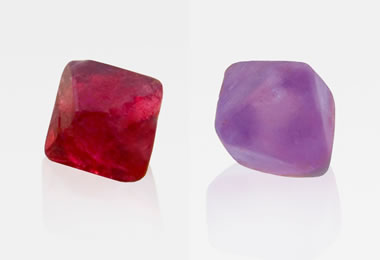
Natural Spinel Crystals: Two natural crystals of spinel, one vivid red, the other frosted purple. Few gems are found as isolated crystals as beautiful as these. Photos by Greg C. Grace / Alamy Stock Photo.
10. Beautiful Crystals
Like diamond, spinel often crystallizes in perfect octahedral crystals. An octahedron is a three-dimensional shape that resembles two four-sided pyramids attached at their bases.
Octahedral crystals of spinel are often mined from marble, but they are more often found as water-worn crystals in stream sediments. Especially nice crystals are highly prized by mineral collectors or mounted as gems without being faceted. Natural crystals can make special gems.
11. Round and Cushion Cut Spinel
Spinel is frequently faceted into round and cushion cut (square with rounded corners) gems. These faceted shapes can be efficiently cut from octahedral spinel crystals with a minimal amount of lost weight.

Black Spinel: A specimen of white quartz with black spinel octahedrons. Photo by Dorling Kindersley ltd / Alamy Stock Photo.
12. Black Spinel
Ceylonite and pleonaste are names used for black spinel. These names are also used for gray and blue spinels that are so dark that they appear to be black (unless they are examined with a bright light). Although these dark spinels are not commonly seen in jewelry, they are exceptionally durable because of their hardness. In addition, their subadamantine luster gives them a brilliant appearance.
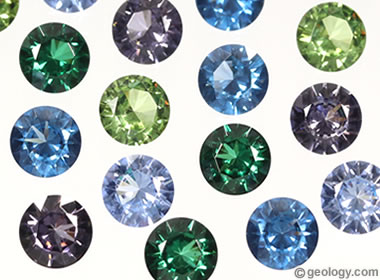
Synthetic Spinel: Faceted synthetic spinel is attractive, inexpensive, and can be made in almost any color. It is one of the most common synthetic materials used to make low-cost birthstone jewelry.
13. Synthetic Spinel
Synthetic spinel was first produced in 1847, but little was used in jewelry until the early 1900s. By the 1930s, synthetic spinels in a wide variety of colors were being made by the Verneuil and flux growth processes. These colored spinels were given trade names such as "tourmaline green spinel" and "cobalt blue spinel". Much of the early birthstone jewelry was set with imitation stones that were actually synthetic spinel. Today very little synthetic spinel is sold as an alternative stone for natural spinel. However, lots of synthetic spinel is still mounted in inexpensive settings and sold as birthstone jewelry.
There You Have It!
I hope that you found enough information to understand why spinel is one of the most underappreciated gems! I hope it becomes one of your favorites!
| More Gemstones |
 |
Tourmaline |
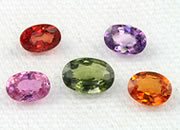 |
Fancy Sapphires |
 |
Diamond |
 |
Canadian Diamond Mines |
 |
Birthstones |
 |
Pictures of Opal |
 |
Fire Agate |
 |
Blue Gemstones |

Find Other Topics on Geology.com:

|

| ||

|

| ||

|

| ||

|

|

